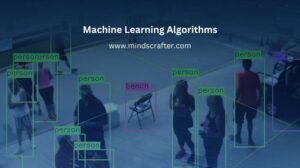
Machine Learning Algorithms
The Top 5 Machine Learning Algorithms You Need to Know:
Machine learning is revolutionizing how we interact with technology, and it’s changing how we do business. From predictive analytics to natural language processing, machine learning algorithms are powering some of the most innovative and ground-breaking technologies of our time. With so many algorithms to choose from, it can be challenging to know which ones to focus on. That’s why we’ve compiled a list of the top five machine learning algorithms you need to know. Whether you’re a developer, a data scientist, or a business owner, understanding these algorithms is essential for staying ahead of the curve. This article will explore each algorithm in detail, highlighting its strengths and weaknesses and providing real-world examples of its use today. So, if you’re ready to take your machine-learning skills to the next level, read on to discover the top five machine-learning algorithms you need to know.
The Top 5 Machine Learning Algorithms:
### Linear Regression Algorithm:
Linear regression is one of the simplest and most widely used machine learning algorithms. It predicts a continuous output variable (Y) based on one or more input variables (X). The algorithm works by finding the line of best fit that minimizes the sum of the squared differences between the predicted and actual values.
Linear regression is commonly used in finance, economics, and social sciences to model relationships between variables. For example, it can predict stock prices based on historical data or customer satisfaction based on survey responses.
Finally, one of the drawbacks of linear regression is that it assumes a linear relationship between the input and output variables. If the relationship between the variables is non-linear, then there may be better algorithms to use than linear regression.
### Decision Tree Algorithm:
The decision tree algorithm is a popular machine learning algorithm that’s used for classification and regression problems. It works by building a tree-like model of decisions and their possible consequences. Each decision node represents a test on an input variable, and each branch represents the trial’s outcome. The leaves of the tree represent the final decision or prediction.
Decision trees are simple to understand and interpret, making them popular for data scientists. They are also helpful in identifying essential variables and interactions between them. Decision trees can be used in various applications, including fraud detection, medical diagnosis, and credit scoring.
Finally, one of the limitations of decision trees is that they can be prone to overfitting. This occurs when the algorithm creates a too-complex tree that fits the training data too closely. To avoid overfitting, it’s important to use techniques such as pruning and cross-validation.
### Naïve Bayes Algorithm:
The Naïve Bayes algorithm is a probabilistic algorithm used for classification problems. It’s based on the Bayes theorem, which states that the probability of a hypothesis (such as a classification label) is proportional to the likelihood of the evidence (such as the input data) given the hypothesis.
The Naïve Bayes algorithm calculates the probability of each classification label given the input data. It then selects the label with the highest probability as the final prediction. Naïve Bayes is a simple algorithm that’s easy to implement and works well with high-dimensional datasets.
Naïve Bayes is commonly used in text classification, spam filtering, and sentiment analysis. For example, it can be used to classify emails as spam or not spam based on their content.
Finally, one of the drawbacks of Naïve Bayes is that it assumes that the input variables are independent of each other. This is often not the case in real-world datasets, which can lead to inaccuracies in the model.
### k-Nearest Neighbors (k-NN) Algorithm:
The k-Nearest Neighbors (k-NN) algorithm is a simple and intuitive algorithm used for classification and regression problems. It works by finding the k closest data points to the input data and using their labels or values to make a prediction.
The k-NN algorithm is simple to implement and works well with small datasets. It’s also helpful in identifying clusters and patterns in data. The algorithm can be used in various applications, including image recognition, recommendation systems, and anomaly detection.
Finally, one of the limitations of the k-NN algorithm is that it can be computationally expensive for large datasets. It’s also sensitive to the choice of k, which can affect the model’s accuracy.
### Artificial Neural Networks (ANNs) Algorithm:
Artificial Neural Networks (ANNs) are a family of machine learning algorithms inspired by the structure and function of the human brain. ANNs are used for various tasks, including classification, regression, and clustering.
ANNs consist of layers of interconnected nodes called neurons. Each neuron receives input from other neurons and calculates a weighted sum of the information. This sum is then passed through an activation function to produce the neuron’s output.
ANNs are powerful algorithms that can learn complex patterns and relationships in data. They are used in various applications, including image and speech recognition, natural language processing, and autonomous vehicles.
Finally, one of the challenges of ANNs is that they can be difficult to train and interpret. They require large amounts of data and computational resources to train effectively. They are also prone to overfitting if not properly regularized.
Applications of Machine Learning Algorithms in Various Industries:
Machine learning algorithms are used in many industries to improve efficiency, reduce costs, and gain insights from data. Here are some examples of how machine learning algorithms are being used in different sectors:
### Healthcare:
Machine learning algorithms are being used in healthcare to improve patient outcomes and reduce costs. For example, algorithms can be used to predict patient readmissions, identify patients at risk of developing chronic diseases, and personalize treatment plans based on patient data.
### Finance:
Machine learning algorithms are being used in finance to improve fraud detection, predict stock prices, and automate trading strategies. For example, algorithms can be used to analyze credit card transactions and detect fraudulent activity in real time.
### Retail:
Machine learning algorithms are being used in retail to improve customer experience and increase sales. For example, algorithms can be used to recommend products to customers based on their browsing and purchase history.
### Manufacturing:
Machine learning algorithms are being used in manufacturing to improve quality control and reduce downtime. For example, algorithms can be used to predict equipment failure and schedule maintenance before it occurs.
Conclusion:
Machine learning algorithms are revolutionizing the way we interact with technology, and they’re changing the way we do business. By understanding the top five machine learning algorithms, you can stay ahead of the curve and take advantage of these algorithms’ many benefits.
Whether you’re a developer, a data scientist, or a business owner, it’s essential to understand the strengths and weaknesses of each algorithm and how they can be applied in different industries. With the right tools and techniques, you can harness the power of machine learning algorithms to make better business decisions, improve customer experience, and gain insights from your data. So, explore these algorithms today and see what they can do for you!

Pingback: AI for Pattern Recognition
Pingback: AI in Risk Management
Pingback: AI and Climate Change
Pingback: AI in Industrial Automation